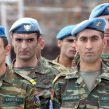
Armenia Plans Troop Deployment in Afghanistan
Publication: Eurasia Daily Monitor Volume: 7 Issue: 8
By:

Armenia is due to send a small contingent of troops to Afghanistan next month, in what will be a largely symbolic boost to the NATO-led multinational force fighting the Taliban insurgency. The deployment, approved by the Armenian parliament last month, has a primarily political significance. It will increase to 43 the number of countries participating in the increasingly challenging mission and highlight Yerevan’s intention to continue to deepen its security links with the West, while remaining Russia’s main ally in the region.
The Armenian government has sought to bolster the military alliance with Moscow, both on a bilateral basis and within the framework of the Russian-led Collective Security Treaty Organization (CSTO), while it worked out the details of its deployment with top NATO representatives during 2009. In late October, the Armenian Defense Minister Seyran Ohanian met with NATO Secretary-General Anders Fogh Rasmussen and several of his Western counterparts on the sidelines of a NATO conference on Afghanistan held in Bratislava, Slovakia. By that time, the alliance officially listed Armenia as one of the partner states making up its International Security Assistance Force (ISAF) in Afghanistan (www.isaf.nato.int).
“Let me express our appreciation to Armenia for its strong contributions to Allied missions, first in Kosovo, and now also in Afghanistan,” Robert Simmons, NATO’s special representative to the South Caucasus and Central Asia, subsequently told journalists in Yerevan (www.armenialiberty.org, November 6). Celeste Wallander, the US Deputy Assistant Secretary of Defense for Russia, Ukraine and Eurasia, likewise discussed the matter with President Serzh Sargsyan and Ohanian during an early December trip to Armenia. “The United States values its partnership with the Republic of Armenia,” Wallander said after the talks (Statement by the US Embassy in Yerevan, December 3).
Following these meetings, the Armenian National Assembly debated and overwhelmingly backed the deployment of 40 soldiers to Afghanistan. Ohanian told the parliament that they will be stationed near the northern Afghan city of Kunduz, and serve there under German command. “I think that this mission will contribute to the accomplishment of our national objectives,” he said. “We will gain a stake in the formation of an international security system.” The minister also noted that neighboring Azerbaijan, Georgia and Turkey are already participants in ISAF (Armenian Public Television, December 8).
The Armenian leadership made similar arguments when it dispatched troops to Kosovo in early 2004 and to Iraq one year later. It doubled the number of Armenian soldiers serving in Kosovo to 70, before pulling out of Iraq in late 2008. The military personnel engaged in those and the Afghan missions serve in a special peacekeeping detachment of Armenia’s armed forces that was formed in 2001 with financial and technical assistance provided by the United States and other NATO member states. The volunteer unit, which currently consists of two battalions, is due to expand into a fully-fledged brigade by 2015 in accordance with Yerevan’s Individual Partnership Action Plan (IPAP), with NATO. The launch of the IPAP in 2005 marked an important milestone in a so-called “complementary” policy pursued by the current and previous Armenian administrations. The cooperation framework committed the South Caucasus state to implement defense reforms aimed at bringing its military into greater conformity with NATO standards and practices. As part of those reforms, the Sargsyan government pushed through the parliament in late 2008 a law that allows the defense ministry to hire civilian personnel. It went on to approve new statutes and structures of the ministry and the Armenian General Staff.
The reforms also resulted in the adoption in 2007 of Armenia’s official national security strategy and military doctrine. Both documents describe close cooperation with NATO as one of the guarantees of the country’s security and independence. They make clear, however, that “strategic partnership” with Russia will remain the bedrock of Armenian defense policy in the foreseeable future.
One key manifestation of that partnership is the presence of Russian troops in Armenia, which essentially precludes any Turkish military interference in Karabakh in favor of Azerbaijan. More importantly, the military alliance with Moscow allows Yerevan to receive Russian weapons at discounted prices or even free of charge. Russian-Armenian military-technical cooperation appeared to intensify after the signing in Yerevan on December 17 of an agreement which the Armenian defense ministry said envisages bilateral “interaction in exporting military products to third countries.” A defense ministry statement to that effect gave no details of the deal. Moreover, Armenia was among five of the seven former Soviet republics aligned in the CSTO, the Russian-dominated defense pact, which formed a NATO-style rapid reaction force in June 2009. Sargsyan joined his counterparts from Russia, Kazakhstan, Kyrgyzstan and Tajikistan in monitoring the first exercises of the Collective Operational Reaction Forces (CORF) held in Kazakhstan in October 2009 (Armenian Public Television, December 8).
Armenia will thus remain cautious in boosting its military ties with the West. The Armenian military stated in the aftermath of the Russian-Georgian war that it will not halt its growing cooperation with NATO, despite increased tensions between the Alliance and Russia over the conflict in South Ossetia (www.armenialiberty.org, August 27, 2008). As if to drive home that point, Yerevan hosted in September-October 2008 NATO-led military exercises, boycotted by Moscow.
However, Armenia backed out of similar drills that were held in Georgia in May 2009 and strongly condemned by the Kremlin. The last-minute decision is widely believed to have been taken under Russian pressure.




